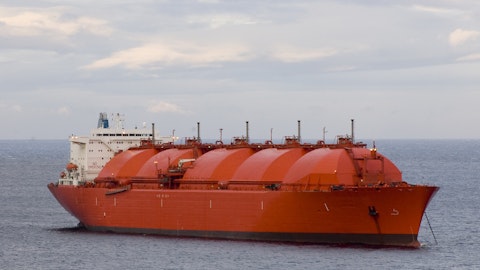FLEX LNG Ltd. (NYSE:FLNG) Q4 2023 Earnings Call Transcript February 7, 2024
FLEX LNG Ltd. isn’t one of the 30 most popular stocks among hedge funds at the end of the third quarter (see the details here).
Øystein Kalleklev: Hi, everybody and welcome to Flex LNG’s Fourth Quarter and Full Year 2023 Presentation. I’m Øystein Kalleklev, CEO of Flex LNG management and I will be joined later today by our CFO, Knut Traaholt, who will run you to the numbers. As usual, we will conclude with a Q&A session, where we have a gift as customary for the best question. This time, we have some nice beanies from almonds [ph] in various colors. And also a nice neck warmer to fit together with beanie. You can ask a question either by using the chat function in the webcast or you can also still send some e-mails to ir@flexlng.com and we will cover those questions in the end when we’re doing the Q&A session. Just a reminder before we begin the presentation about our disclaimer, we will provide some forward-looking statements.
There are some non-GAAP measures. And of course, there are limited how many details we can cover in the presentation so let’s kick off. Revenues for the quarter came in at $97.2 million. This was in line with the guidance provided for Q4 of around $97 million to $99 million. Net income and adjusted net income came in at $19.4 million and $37.8 million, respectively. Just a reminder, we have a rather big portfolio of interest rate derivatives, where we’ve hedged ourself against higher interest rate we are today experiencing. And in the adjusted numbers, we only include the realized gain and loss on derivatives while we take the change unrealized change in value are included in the net income numbers. But as Knut will tell you shortly, we have made rather big gains on derivatives during the last three years to a total of $116 million positive.

So this translates into our earnings per share and our adjusted earnings per share of $0.36 and $0.70, respectively. As we are now in February and heading out of the peak heating season, not surprisingly, rates are softening following the seasonal pattern where typically freight rates find the bottom at around March before starting to fire up again for the summer season. And I will cover more of the freight market in detail later in the presentation. As we have recently announced, we have got or received an extension of one of our ships, Flex Resolute. She has now been on our time charter for about two years. This time charter is for three years, where the charter — a super major has option to extend by two plus two years. And they have now declared the first option taking this vessel firm until at least the first quarter of 2027.
Then as we announced on January 8, we have redelivery of Flex Constellation either end of Q1 or in Q2. This ship has been on a three year time charter with the trading house and we will get back and we plan to carry out the dry docking of the ship before then marketer for spots, medium-term or longer-term time charters, depending a bit on the market conditions. For next quarter, Q1 which we are already way into, we expect rates to soften a bit, depending a bit on where the spot market is trading as we have one ship on a variable time charter, Flex Artemis so we expect time charter equivalent earnings of somewhere around $75,000 to $80,000 per day. Guiding also in terms of revenues and adjusted EBITDA around $90 million of revenues and $70 million of adjusted EBITDA, quite similar to the results achieved in Q1 last year.
We have two dockings scheduled for this year, last year, as some of you might recall, we were carrying out drydock in the first drydocking special survey of four ships altogether. This year, we only have two ships. It’s the Constellation which we will lock end of Q1 or Q2 depending when we get them back and then Courageous is scheduled for drydocking in the second quarter. With strong results, our very healthy backlog which I will cover shortly, we are pleased to once again pay out a dividend of $0.75 per share for the quarter. So this gives, in total, our dividend 2023, of $3 and $12.5 [ph] per share and that should give a yield of around 11%. Stock market here in Oslo is down today, our stock has recovered a bit, down 5.5%, driven a bit by the sentiment around Equinox Capital Markets Day, where they cut our dividend and Equinox is down 5%, 6% today.
See also 10 Best Cheap Car Insurance in California for 2024 and 15 States Where People Are Fleeing.
Q&A Session
Follow Flex Lng Ltd. (NYSE:FLNG)
Follow Flex Lng Ltd. (NYSE:FLNG)
And lagging on the energy sector. So hopefully, we can provide you some info and give on photon results of Flex LNG despite the kind of sell-off in the energy market here in Oslo today. So let’s review our guidance. So last year, we provided a fairly detailed guidance for the full year, given the fact we had 100% coverage for the year. So we guided on three key measures time charter equivalent which is the average rate we obtained on our ships. We guided at approximately $80,000 for the full year, delivered slightly better in Q4. That’s the peak season, $81,100 [ph] and average for the year, we ended up at $79,500, so very much in line with the guidance provided. Revenues, we guided approximately $170 million and I’m pleased to say we beat that by $1.371 million [ph] and then we guided the last measure was adjusted EBITDA of $290 million to $295 million.
We delivered $290 million and the reason why we didn’t meet the midpoint is we had some technical off-hire days last year. We have had extremely few technical days during the — yes, more than 5 years, we’ve been trading these ships but we had some last year and affected slightly on the adjusted EBITDA. Looking forward to Q1, as I said, it will be more or less similar to the numbers we delivered Q1 last year, depends a bit on the timing of the constellation docking and also how the spot market is performing but revenue so far $90 million, adjusted EBITDA of around $170 million and then our range share on the TCE achieved of $75,000 to $80,000 per day. During the last couple of years, we took delivery of the first ship Flex endeavor 9 January 2018 and then this is the ship [ph], 11 January 2018.
And then we’ve been building up the numbers of ships on the water. Last ship, we took delivery of was in, I believe it was May 30 to May 31, 2021, the Flex Vigilant. So from Q3 2021, we had all of fleet on the water generating earnings. And then we started off with most of our ships in the spot market. That really paid off in ’21 when the market was rolling a bit more challenging during COVID. And then from ’21, ’22 onwards, we’ve mostly locked in rather long charters on all of ships and stabilized both the revenues and then the adjusted EBITDA since basically all our costs are fixed. And as you can see, variability in adjusted EBITDA is very small. We had a bit of a dip in Q2 last year but that was mainly driven by the fact that we carried out talking of three ships in Q2 last year.
This year, as I mentioned, we only have docking of two ships. Looking at the fleet profile. So this backlog, I mentioned, is backed by high contract coverage. We have very limited open ships near term. This year, we are already 94% coverage on contracts. We have one ship, as I mentioned, the Flex Constellation coming back from a 3-year time charter opening up end of Q1, early Q2. And as I mentioned, we plan to dock her. That typically takes alone 20 days and then she will be available at a good period of time, I think, once we are out of the bottom of the market typically. So we also have one ship linked to the spot market by the factory has a variable time charter. It’s the Flex Artemis which is on a 5-year charter but where the charter has options to extend that contract by 5 years.
As mentioned, Flex Resolute, this extended to 2027, where there is a similar option for the sister ship Flex Courageous. So let’s see if we also add some more backlog here during the year. And then as you see, we have very limited open availability here near term. We will have a bit softer market in terms of volumes hitting in the market compared to ships for ’24, ’25. And then there’s a lot of new LNG coming to the market, ’26, ’27, ’28 and onwards. And actually, that’s a period now where contracting of ships are tailing off because of the very high ship prices. So we think we are well positioned, minimum 50 years of charter backlog. We think we will add some more charter backlog this year by a declaration of further options which could bring the total up to a total of 75 years.
And all these charters are blue-chip counterparties. Looking at dividends. So we have a stable business backed by a lot of first-class backlog and we are generating substantial cash flow. And as I’ve covered in the past, we are a very shareholder-oriented company where we do think that all these earnings belongs to shareholders and we are paying this out regularly on a quarterly basis, this quarter, we are paying out $0.75, slightly higher than the adjusted earnings, given the fact that we have our various sound financial position with $411 million of cash, no upcoming maturities, a lot of backlog and very limited CapEx liabilities since we have no ships under construction and CapEx liabilities are limited to dry dockings. And this year, we have the drydocking of two ships which should be in the range of $10 million altogether in CapEx for those two ships.
So very sound, stable business and last slide here before giving it over to Knut is, with this business, we have generated substantial returns. We listed this company almost five years ago now, June 2019 in New York at $11. We paid out almost the same amount, $9 in dividends, if you reinvested the dividends, you would do even better. And then on top of that, we have had a share price appreciation. Right now, the stock is down today. So it’s — the 280% [ph] is a bit less but still a very good return. And for those who are fan of Warren Buffett, he knows that the market in the short run, it’s a voting machine, in the long run, it’s a waiting machine and gravity tends to favor the good businesses. And as he says in this book, Snowball, Time is the friend of the wonderful business, the enemy of the mediocre.
So we certainly delivered on that philosophy. We are paying out the free cash flow. And in the Russell 2000, consisting of stocks in New York, we are in the top 2% of companies in terms of dividend payout with 11% — I haven’t calculated but probably 12% today with the stock price. So I think it’s a good time to be invested in Flex. And I will come back and give a bit more update on the market. First now, we will head over to Knut I hope you give him a warm welcome. Knut is 46 years today so it’s his birthday. So come Knut and I hope you can get yourself a beanie afterwards as well as a gift. Here you know typically, if you’re single, you go with a green beanie. If you’re not, you have red, if you undecided you have a white one. So I’m curious to see which kind of beanie you’re going to elect to have.
Last year, there was an LNG carrier which was scrapped at age of 46 years, your same age, the [indiscernible]. But he is still operating in the LNG business.
Knut Traaholt: Thank you, Øystein. I think we can hand over to the summary of the operational figures for the fourth quarter and for the full year. If you look at operating days in the second quarter, we had 77 days of hire related to the dry docking. And then we had, in the first three quarters, 19 days of technical off-hire. In the fourth quarter, we had 100% technical uptime. And that results in a technical uptime and commercial availability for the year of 99.6%. That’s a strong testament to our onshore technical and operations team and also for our crew members on board, keeping the propeller running. If we look at the time charter equivalent per day in the fourth quarter, we had $81,100. And then for the full year, $79,500 which is at par with our guiding.
OpEx for the fourth quarter is somewhat higher. That was guided on the Q3 presentation, another was mainly related to scheduled maintenance of our auxiliary engines. But however, as we guided on the total OpEx for the year, we end up at $14,400 versus the guidance of $14,500. For 2024, we guide an OpEx of $14,900 and that is mainly an increase in crew wages and some technical. That results in revenues of $97 million for the quarter and $371 million for the full year which is also as guided. An EBITDA of $76 million for the quarter and $290 million for the full year. That resulted in adjusted net income of $38 million for the quarter or $137 million for the year. And in the adjusted numbers, we adjust out unrealized gains and losses from our derivative portfolio.
And then, as you may recall from closing of our balance sheet optimization program in the first quarter, we also strip out the noncash write-off of debt issuance costs. So then looking into the more details and we’ve been through the revenues and the OpEx. Then the main differences are on the derivative portfolio. The paid interest is on par quarter-by-quarter. And then the difference is on this quarter a loss on the derivative portfolio of an unrealized loss of $18.7 million and then a realized gain of $7.1 million which is offsetting our interest cost. That gives us a net income of $19.4 million for the quarter. And if we then adjust out the noncash items, we have adjusted net income of $37.8 million or adjusted earnings per share of $0.70.



